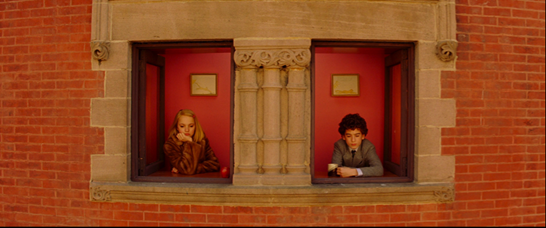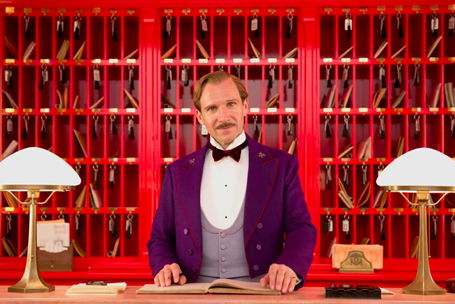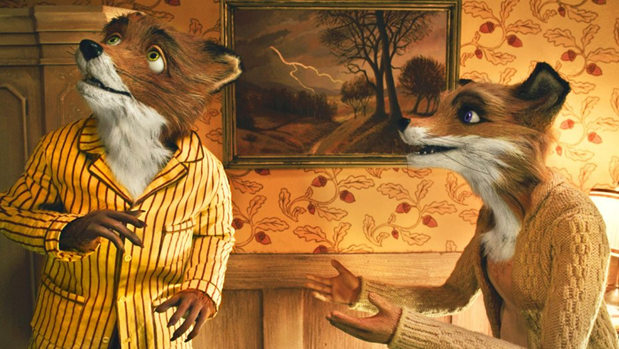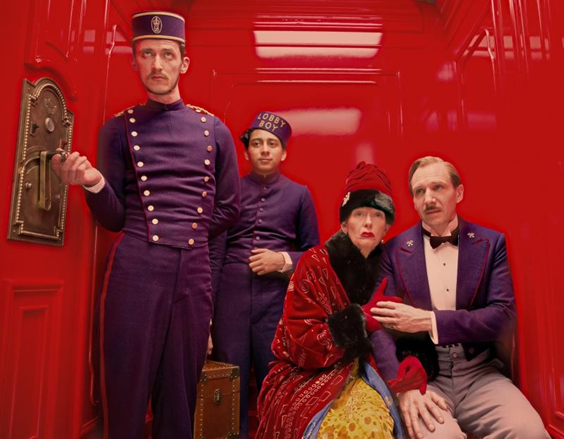Though I personally believe that films are a collaborative work and that not one person wholly responsible for the copious amount of work that goes into one film, its hard to deny that Wes Anderson’s films have a distinguishable style.
So for arguments sake, how why could Wes Anderson be considered an auteur?
According to auteur theory a director can be considered the author of a film if the body of their work constantly demonstrates a high level of technical competence, a distinguishable personality and overriding theme and/or meaning (Stam, 2017). As such, Wes Anderson is the quintessential example of a modern-day auteur as his films consistently uphold these criteria. This evident due to the matriculas detail in the cinematography, Mise-en-Scene and motifs demonstrated in a plethora of Wes Anderson’s films.
To elaborate, many of Wes Anderson’s films exhibit unique cinematography that denote his high-level technical competence and express his distinguishable personality as an auteur.
For instance, many of the shots in Wes Anderson’s films are symmetrical and centre framed, as appose to following the rule of thirds (Heiderich, 2018). Moreover, Wes Anderson often makes use of rectilinear shots to further highlight symmetry, as demonstrated in a shot from The Royal Tenenbaums (2001) shown in figure 1 and in another shot from The Grand Budapest Hotel (2014) figure 2. This is clearly an intentional decision by the director in order to not only grab the audience’s attention, but to also make a scene feel unnatural and staged (Heiderich, 2018). By doing so, it appears as if the audience is watching a play on a set as appose to a film set in real life. Thus, demonstrating the technical competence of the director as he can achieve the desirabed effect from the use of cinematography techniques (Stam, 2017).

This is further perpetuated in the numerous tracking shots shown in Wes Anderson films. In The Darjeeling Limited (2007) for example, a tracking shot is used to show what is going on with side characters as if they are in different cars of the same train, like a diorama stage set. In addition, tracking shots are also used to show characters entering different rooms of the ‘set’ in The Grand Budapest Hotel (2014) and Fantastic Mr. Fox (2009). This again promotes the notion that Wes Anderson’s films are set on a stage, as the way the tracking shots intentionally make it appear as if it is filmed on a carefully constructed set. This stylistic choice is clearly a part of the director’s distinguishable personality as an auteur (Stam, 2017).

Furthermore, Wes Anderson also frequently makes use of high angle point of view shots in his films. These shots are primarily used to show the audience objects such as the Whitman brothers travel itinerary in The Darjeeling Limited (2007) or the schematics to a scheme in Fantastic Mr. Fox (2009). This makes the audience become more invested in the perception of the characters (Branigan, 2012). Thus, the audience gains a deeper emotional attachment to the film and characters, despite it lacking realism (Wilkins, 2014). The ability to subtlety create an emotional attachment is again a clear indicator of Wes Anderson’s technical competence and assists in establishing his personality as an auteur (Stam, 2017).
The cinematography is used to convey the notion the films are not set in the ‘real world’, but instead in a world of Wes Anderson’s own design. Furthermore, the recurring nature of these cinematography techniques have become a trademark of the director. Thus, these distinct stylistic choices not only demonstrate Wes Anderson’s technical competence but also his own personality as an auteur (Stam, 2017).
Wes Andersons distinctive personality and recurring themes are further demonstrated in the Mise-en-Scene of his films. He consecutively creates striking and imaginative worlds within his films through matriculas detail with regard to colour palette, costumes and even acting style.

The colour palette of many of Wes Anderson’s films takes some inspiration from the Art Nouveau movement whilst still incorporating bolder colours (Maiden, 2017). This is clearly demonstrated in Fantastic Mr. Fox (2009), the colour palette incorporates brown, gold, mustard, olive and off white as well as other pastel colours indicative of the Art Nouveau movement as seen in figure 3 (Maiden, 2017). Moreover, in The Grand Budapest Hotel (2014) similar Nouveau colours are used in conjunction with brighter colours, such as fire engine red and violet demonstrated in figure 4. This unique colour palette is not only eye-catching but adds to the idea of a constructed world. As this colour scheme goes against the idea of realism but perpetuates the notion of escapism, which is a recurring theme in Wes Anderson films. It should be noted that recurring themes are an integral part of what makes a director an auteur (Stam, 2017).

The costume design in Wes Anderson’s films incorporate not only bold colours, but also the personalities and traits of the characters themselves. This is evident when examining J.G. Jopling’s (Willem Dafoe’s) costume from The Grand Budapest Hotel (2014); Jopling is first seen wearing a black leather trench coat and brass knuckles which signify to the audience that he is a villain. Furthermore, Henry Sherman (Danny Glover) from The Royal Tenenbaums (2001) sports a navy-blue suit and orange bow tie which not only add to the colour palette but are also associated with the character’s high level of intelligence. Thus, the audience can know what to expect from these characters, as well as others, simply because of their costume design (Lorenzo, 2004). In addition, the cartoon-like nature of the costume design adds to the escapist nature of Wes Anderson’s films. Which demonstrates not only the director’s personality, but also his technical competence through the way he is able to successfully communicate meaning to his audience through costume design (Stam, 2017).
Though the characters in Wes Anderson films are distinctive, they are purely idiosyncratic characters that are not identifiable with real people (Wilkins, 2014). To illustrate, they have an unusual pattern of speech, wherein their lines are often delivered in a dry and exacting way. Particularly when Richie Tenenbaum (Luke Wilson) from The Royal Tenenbaums (2001) delivers the line: “Of course it’s dark it’s a suicide note”, it’s as if the character is completely unaware of the irony of such a statement. Moreover, when Francis Whitman (Owen Wilson) from The Darjeeling Limited (2007) also delivers his lines in a dry manner, even when he makes serious statements, such as “I crashed on purpose”. This is draws on humour that is derived from juxtaposition between the nature of the lines themselves and the delivery. As such, this further portrays Wes Anderson’s distinctive style of humour and personality. Additionally, the idiosyncratic nature of the characters also alludes to the overriding theme of escapism that is explored throughout his body of work.
As such, the overall Mise-en-Scene of Wes Anderson’s films not only convey and an overriding theme through his body of work, but also display his personality and technical competence as not only a director but an auteur (Stam, 2017).
Without a doubt recurring themes, or motifs, are crucial part of what makes a director an auteur (Stam, 2017). Many of Wes Anderson’s films feature motifs, such as the previously mentioned escapism theme as well as others.
To recap, escapism is a motif that is frequently explored throughout Wes Anderson’s film through cinematography and Mise-en-Scene. Wes Anderson himself stated that he likes to create films “where there is an invented reality and the audience is going to go someplace where hopefully they’ve never been before” (IMDB). As previously discussed, this motif is demonstrated in a plethora of his films and it has also become a part of his distinguishable personality as an auteur.
However, escapism is not the only motif within his films, another motif that is frequently used through is films are artists. Artists and their creations play an important role in numerous Wes Anderson films, such as Mrs. Fox (Meryl Streep), from Fantastic Mr. Fox (2009), whose skills as a painter are used to make a map that plays a crucial role in taking down the farmers. Moreover, when Margot (Gwyneth Paltrow), from The Royal Tenenbaums (2001), goes back to playwriting after taking a long break from her art, it symbolises her personal growth. Her brother Richie (Luke Wilson) also uses art to understand and process his feelings for his adopted sister. As such, art not only plays an important role as a plot device, but also to symbolise the emotions of various characters. The use of this motif has become a part of the director’s personality and symbolises the overriding theme of growth.
Many believe that an auteurs personal experiences have an influence on their work and are often explored through motifs (Stam, 2017). This is true of Wes Anderson, as the motif of dysfunctional families and a lack of stable parental figures, which is frequently explored in his films, is informed by his own experiences growing up (IMDB). When Wes Anderson was very young his parents divorced, which he described as “the most crucial event” during his and his brothers’ childhoods (IMDB). This is also explored in The Darjeeling Limited (2007) as the Whitman brothers carry baggage both latterly and symbolically due to effect of the sudden death of their father and the lack of support from their mother. In the final scene they leave their suitcases behind, which are symbolic of their emotional baggage, and so that they are able to catch their train and continue with their journey. Thus, symbolising that they have made peace with their pasts and are now moving on with their lives. A similar event is explored in The Royal Tenenbaums (2001), wherein the parent’s differences and subsequent divorce effects their children in various ways during both childhood and adulthood. In particular, Margot Tenenbaum (Gwyneth Paltrow) acts in a rebellious fashion in an attempt to cope with the situation, which mirrors how Wes Anderson himself tried to cope with his parent’s divorce (Biography, 2019). Thus, it can be concluded that Wes Anderson’s own personal experiences has had a perfuse effect on his work as an auteur and contributed to the formation of the overriding theme of growth and reconciliation (Stam, 2017).
In conclusion, Wes Anderson displays a high level of technical competence, a distinguishable personality and the body of his work contain various overriding themes (Stam, 2017). This is demonstrated through his control over cinematography, Mise-en-Scene and motifs. As such, Wes Anderson is undoubtably the quintessential example of a modern-day auteur (Stam, 2017).
Reference List:
Anderson, W. W. (Director). (2009). Fantastic Mr. Fox [Motion picture] United States of America
Anderson, W. W. (Director). (2007). The Darjeeling Limited [Motion picture] United States of America
Anderson, W. W. (Director). (2014). The Grand Budapest [Motion picture] United States of America
Anderson, W. W. (Director). (2001). The Royal Tenenbaums [Motion picture] United States of America
Biography. (2019, August 14). Wes Anderson. Retrieved from https://www.biography.com/filmmaker/wes-anderson
Branigan, E. (2012). Point of view in the cinema: A theory of narration and subjectivity in classical film (Vol. 66). Walter de Gruyter.
Heiderich, T. (2018). Cinematography techniques: The different types of shots in film. Ontario Mining Assosiation. Recuperado de https://www. oma. on. ca/en/contestpages/resources/free-report-cinematography. pdf.
IMDB. (n.d.). Wes Anderson. Retrieved from https://www.imdb.com/name/nm0027572/bio
Lorenzo, W. (2004) Costume Design and Identity.
Maiden, S. (2017). Grotesque and Decadent Productions: Aubrey Beardsley and the Art Nouveau. Manuscript, https://www. academia. edu/35660495.
Sarris, A. (2007). Notes on the’Auteur’Theory in 1962. Kwartalnik Filmowy, 59, 6-17.
Schepelern, P. (2005). The Making of an Auteur. Visual Authorship: Creativity and Intentionality in Media, 103.
Stam, R. (2017). Film theory: an introduction. John Wiley & Sons.
Wilkins, K. (2014). Cast of Characters: Wes Anderson and Pure Cinematic Characterization. In The Films of Wes Anderson (pp. 25-37). Palgrave Macmillan, New York.
References for Images Only:
Ehrlich, D. (2019, October 03). Wes Anderson Movies Ranked From Worst To Best. Retrieved from https://www.indiewire.com/feature/wes-anderson-movies-ranked-rushmore-royal-tenenbaums-fantastic-mr-fox-1201811293/
Linden, S. (2019, November 13). ‘Fantastic Mr. Fox’: Film Review. Retrieved from https://www.hollywoodreporter.com/review/fantastic-mr-fox-review-movie-2009-93658
Potterton, J. (2015). A Visual Analysis of Wes Anderson’s The Royal Tenenbaums. Retrieved from https://www.fusionmagazine.org/a-visual-analysis-of-wes-andersons-the-royal-tenenbaums/
Rotten Tomates (n.d.). The Grand Budapest Hotel. Retrieved from https://www.rottentomatoes.com/m/the_grand_budapest_hotel#&gid=1&pid=h-112445